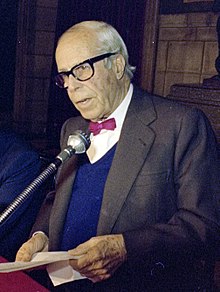Josep Lluís Sert
Josep Lluís Sert i López (born July 1, 1902 in Barcelona , Spain ; † March 15, 1983 ibid.) Was a Spanish architect and urban planner.
Life
Born in Barcelona in 1902, the Catalan Sert became interested in the work of Gaudí as well as in the paintings of his uncle Josep Maria Sert at an early age . He studied at the Barcelona School of Architecture.
After graduating from the Escuela Superior de Architectura , where he studied from 1921 to 1928, he worked in Paris with Le Corbusier and Pierre Jeanneret . With them and other like-minded people, he founded GATEPAC (Spanish Grupo de Artistas y Técnicos Españoles Para la Arquitectura Contemporánea , “Group of Spanish artists and technicians for modern architecture”).
Sert designed the Spanish pavilion for the 1937 World's Fair . In 1939 he moved to America and worked on urban development projects in Bogotá and Havana, among others .
In 1952, Sert was a visiting professor at Yale University for one year . The following year he succeeded Walter Gropius as dean of the Harvard Graduate School of Design , where he remained until 1969. In 1954 he was elected to the American Academy of Arts and Sciences .
During his time at Harvard in 1955, Sert founded an architecture firm with a number of partners and worked on projects in the United States , including office buildings, public buildings, department stores and residential buildings. In the neighborhood of Harvard University , Sert created some of his most famous buildings.
Josep Lluis Sert was President of the Congrès International d'Architecture Moderne between 1947 and 1956, and his development is closely linked to the history of this group.
His work combines the concerns of urban planning with an architecture that has its roots in the Mediterranean region. In architecture, he advocated an intensive relationship with art. During his years in Paris in particular, he had contact with Pablo Picasso , Fernand Léger , Joan Miró and Alexander Calder .
Works
His most famous buildings are the pavilion for the Spanish Republic at the Paris World Exhibition of 1937, which he created together with Luis Lacasa , the workshop for Joan Miró in Cala Major , a suburb of Palma de Mallorca , the Harvard student dormitories with their restless contours in 1956 (1962–64) the American embassy in Baghdad and the Maeght Foundation in Saint-Paul-de-Vence near Nice in France (1959–64) and the finca houses on Ibiza, for example Casa Sert (1968–1971).
The Maeght Foundation combines nature and architecture in an ingenious way. The concrete and glass building, which rests on a rock plinth, encloses a courtyard that is open to one side. The interiors, with white walls and large openings through which one can see the landscape, are illuminated by the natural light reflected from the roof. The study center of contemporary art, the Fundació Joan Miró , in Barcelona has a similar construction . It was built by Sert in 1975.
Buildings (selection)
- Dispensario Antituberculoso , Barcelona
- Edificio de Viviendas en la calle Muntaner , Barcelona
- Escuela del Segell Pro Infància , Arenys de Mar
- Pabellón de la República , Barcelona
- Spanish Pavilion , 1937 World's Fair , Paris
- Fundació Joan Miró , Barcelona, 1975
- Fundació Pilar i Joan Miró a Mallorca , Palma
- Maeght Foundation , Saint-Paul-de-Vence
- Science Center , Harvard University , Boston
- Apartment building at Harvard University , Boston
- Holyoke Center , Boston
- United States Embassy , Baghdad
- Carmel de la Paix à Mazille , Saône-et-Loire , 1971
literature
- JJ Sweeney and JL Sert: Antoni Gaudí . Hatje publishing house, Stuttgart 1960
Web links
| personal data | |
|---|---|
| SURNAME | Sert, Josep Lluís |
| ALTERNATIVE NAMES | Sert i López, Josep Lluís; Sert, José Luis |
| BRIEF DESCRIPTION | Spanish architect |
| DATE OF BIRTH | July 1, 1902 |
| PLACE OF BIRTH | Barcelona , Spain |
| DATE OF DEATH | March 15, 1983 |
| Place of death | Barcelona , Spain |


